Spatiotemporal Variation and Influencing Factors of Vegetation Growth in Mining Areas: A Case Study in a Colliery in Northern China
Abstract
1. Introduction
2. Materials and Methods
2.1. Study Area Profile
2.2. Data Source and Processing
2.3. Methodology
2.3.1. Maximum Value Composite
2.3.2. Time Series Analysis
2.3.3. Trend Analysis
2.3.4. Simple Correlation Analysis
2.3.5. Multiple Correlation Analysis
2.3.6. Partial Correlation Analysis
3. Results
3.1. Analysis of Vegetation Spatiotemporal Variation Characteristics
3.1.1. Interannual Variation Trend of Vegetation
3.1.2. Spatial Distribution Characteristics of Vegetation
3.1.3. Spatial Pattern of EVI Variation
3.2. Sensitivity Analysis of EVI to Precipitation
3.3. Correlation Analysis of EVI to Coal Mining and Precipitation
3.3.1. Multiple Correlation Analysis
3.3.2. Partial Correlation Analysis
4. Discussion
5. Conclusions
Author Contributions
Funding
Institutional Review Board Statement
Informed Consent Statement
Data Availability Statement
Acknowledgments
Conflicts of Interest
References
- Li, W.; Duan, L.; Wang, W.; Wu, Y.; Liu, T.; Quan, Q.; Chen, X.; Yin, H.; Zhou, Q. Spatiotemporal characteristics of drought in a semi-arid grassland over the past 56 years based on the Standardized Precipitation Index. Meteorol. Atmos. Phys. 2021, 133, 41–54. [Google Scholar] [CrossRef]
- Manzoni, S.; Katul, G.; Fay, P.A.; Polley, H.W.; Porporato, A. Modeling the vegetation-atmosphere carbon dioxide and water vapor interactions along a controlled CO2 gradient. Ecol. Model. 2011, 222, 653–665. [Google Scholar] [CrossRef]
- Gao, C.; Huang, C.; Wang, J.; Li, Z. Modelling Dynamic Hydrological Connectivity in the Zoigê Area (China) Based on Multi-Temporal Surface Water Observation. Remote Sens. 2022, 14, 145. [Google Scholar] [CrossRef]
- China National Coal Association. Annual Report on Coal Industry Development 2020. Available online: http://www.coalchina.org.cn/uploadfile/2021/0303/20210303022435291.pdf (accessed on 3 March 2021).
- Jin, J.; Yan, C.; Tang, Y.; Yin, Y. Mine Geological Environment Monitoring and Risk Assessment in Arid and Semiarid Areas. Complexity 2021, 2021, 3896130. [Google Scholar] [CrossRef]
- Zhang, L.; Zhang, S.; Ye, H.; Huang, Y. Landscape Indices of Land Damage and Land Reclamation in an Opencast Coal Mine. Resour. Sci. 2014, 36, 55–64. [Google Scholar]
- Li, C.; Wang, T.; Wang, H.; Hu, Z.; Jiang, X.; Liang, Z.; Wang, W.; Du, B. Monitoring technology and method of ecological environment rehabilitation and treatment in Jvhugeng mining area. J. China Coal Soc. 2021, 46, 1451–1462. [Google Scholar] [CrossRef]
- Li, S.; Xiao, W.; Zhao, Y.; Lv, X. Incorporating ecological risk index in the multiprocess MCRE model to optimize the ecological security pattern in a semi-arid area with intensive coal mining: A case study in northern China. J. Clean. Prod. 2020, 247, 119143. [Google Scholar] [CrossRef]
- Scher, C.L.; Karimi, N.; Glasenhardt, M.C.; Tuffin, A.; Cannon, C.H.; Scharenbroch, B.C.; Hipp, A.L. Application of remote sensing technology to estimate productivity and assess phylogenetic heritability. Appl. Plant Sci. 2020, 8, e11401. [Google Scholar] [CrossRef]
- You, Z.; Liu, L.; Bethel, B.; Dong, C. Feature Comparison of Two Mesoscale Eddy Datasets Based on Satellite Altimeter Data. Remote Sens. 2021, 14, 116. [Google Scholar] [CrossRef]
- Lan, S.; Dong, Z. Incorporating Vegetation Type Transformation with NDVI Time-Series to Study the Vegetation Dynamics in Xinjiang. Sustainability 2022, 14, 582. [Google Scholar] [CrossRef]
- Li, H.; Wu, M.; Tian, D.; Wu, L.; Niu, Z. Monitoring and analysis of the expansion of the Ajmr Port, Davao City, Philippines using multi-source remote sensing data. Peer J. 2019, 7, e7512. [Google Scholar] [CrossRef]
- Lee, K.; Sung, H.; Seo, J.; Yoo, Y.; Kim, Y.; Kook, J.; Jeon, S. The Integration of Remote Sensing and Field Surveys to Detect Ecologically Damaged Areas for Restoration in South Korea. Remote Sens. 2020, 12, 3687. [Google Scholar] [CrossRef]
- Jenkins, L.; Barry, T.; Bosse, K.; Currie, W.; Christensen, T.; Longan, S.; Shuchman, R.; Tanzer, D.; Taylor, J. Satellite-based decadal change assessments of pan-Arctic environments. Ambio 2020, 49, 820–832. [Google Scholar] [CrossRef]
- Maleki, S.; Soffianian, A.; Soltani Koupaei, S.; Saatchi, S.; Pourmanafi, S. Application of Remote Sensing in Monitoring Unsustainable Wetlands: Case Study Hamun Wetland. J. Ind. Soc. Remote Sens. 2018, 46, 1871–1879. [Google Scholar] [CrossRef]
- Lei, F.; Yu, Y.; Zhang, D.; Feng, L.; Guo, J.; Zhang, Y.; Fang, F. Water remote sensing eutrophication inversion algorithm based on multilayer convolutional neural network. J. Intell. Fuzzy Syst. 2020, 39, 5319–5327. [Google Scholar] [CrossRef]
- Bourouhou, I.; Salmoun, F. Sea water quality monitoring using remote sensing techniques: A case study in Tangier-Ksar Sghir coastline. Environ. Monit. Assess. 2021, 193, 557. [Google Scholar] [CrossRef]
- Sun, G.; Jiao, Z.; Zhang, A.; Li, F.; Fu, H.; Li, Z. Hyperspectral image-based vegetation index (HSVI): A new vegetation index for urban ecological research. Int. J. Appl. Earth Obs. Geoinform. 2021, 103, 102529. [Google Scholar] [CrossRef]
- Zhou, B.; Li, H.; Xu, F. Analysis and discrimination of hyperspectral characteristics of typical vegetation leaves in a rare earth reclamation mining area. Ecol. Eng. 2022, 174, 106465. [Google Scholar] [CrossRef]
- Yang, Z.; Li, W.; He, J.; Liu, Y. An assessment of water yield properties for weathered bedrock zone in Northern Shaanxi Jurassic coalfield: A case study in Jinjitan coal mine, Western China. Arab. J. Geosci. 2019, 12, 720. [Google Scholar] [CrossRef]
- Wang, B.; Liu, J.; Wang, C.; Zhang, X. Effects of drawing damage on root growth and soil reinforcement of Hippophae rhamnoides in a coal mining subsidence area. Int. J. Phytoremediat. 2022, 24, 409–419. [Google Scholar] [CrossRef]
- Gao, Y.; Dang, X.; Wang, J.; Gao, Q.; Zhai, B.; Liu, B. Damage Characteristics of Populus Simonii Root Systems at Different Cracks in Mining Subsidence Area. J. Soil Water Conserv. 2022, 42, 34–41. [Google Scholar] [CrossRef]
- Chen, W.; Li, W.; Yang, Z.; Wang, Q. Analysis of mining-induced variation of the water table and potential benefits for ecological vegetation: A case study of Jinjitan coal mine in Yushenfu mining area, China. Hydrogeol. J. 2021, 29, 1629–1645. [Google Scholar] [CrossRef]
- Dong, S.; Liu, B.; Ma, M.; Xia, M.; Wang, C. Effects of groundwater level decline to soil and vegetation in arid grassland: A case study of Hulunbuir open pit coal mine. Environ. Geochem. Health 2022. ahead of print. [Google Scholar] [CrossRef]
- Li, X.; Lei, S.; Cheng, W.; Liu, F.; Wang, W. Spatio-temporal dynamics of vegetation in Jungar Banner of China during 2000–2017. J. Arid Land. 2019, 11, 837–851. [Google Scholar] [CrossRef]
- Chen, T.; Shu, J.; Han, L.; Tian, G.; Yang, G.; Lv, J. Modeling the effects of topography and slope gradient of an artificially formed slope on runoff, sediment yield, water and soil loss of sandy soil. Catena 2022, 212, 106060. [Google Scholar] [CrossRef]
- Zhang, Q.; Ma, J.; Yang, Y.; Luo, Z.; Wang, Y.; Chen, F. Mining Subsidence-Induced Microtopographic Effects Alter the Interaction of Soil Bacteria in the Sandy Pasture, China. Front. Environ. Sci. 2021, 9, 656708. [Google Scholar] [CrossRef]
- Zhang, K.; Yang, K.; Wu, X.; Bai, L.; Zhao, J.; Zheng, X. Effects of Underground Coal Mining on Soil Spatial Water Content Distribution and Plant Growth Type in Northwest China. ACS Omega 2022, 7, 18688–18698. [Google Scholar] [CrossRef]
- Feng, H.; Zhou, J.; Zhou, A.; Bai, G.; Li, Z.; Chen, H.; Su, D.; Han, X. Grassland ecological restoration based on the relationship between vegetation and its below-ground habitat analysis in steppe coal mine area. Sci. Total Environ. 2021, 778, 146221. [Google Scholar] [CrossRef] [PubMed]
- Li, N.; Yan, C.Z.; Xie, J.L. Remote sensing monitoring recent rapid increase of coal mining activity of an important energy base in Northern China, a case study of Mu Us Sandy Land. Resour. Conserv. Recy. 2015, 94, 129–135. [Google Scholar] [CrossRef]
- Saedpanah, S.; Amanollahi, J. Environmental pollution and geo-ecological risk assessment of the Qhorveh mining area in western Iran. Environ. Pollut. 2019, 253, 811–820. [Google Scholar] [CrossRef] [PubMed]
- Sun, W.; Zhang, H.; Cao, Y.; Zhang, X.; Ji, X.; Li, F. Monitoring the ecological environment of open-pit coalfields in cold zones of Northeast China using Landsat time series images of 2000–2015. Teh. Vjesn. 2017, 24, 129–139. [Google Scholar] [CrossRef][Green Version]
- Yang, Z.; Li, W.; Li, X.; He, J. Quantitative analysis of the relationship between vegetation and groundwater buried depth: A case study of a coal mine district in Western China. Ecol. Indic. 2019, 102, 770–782. [Google Scholar] [CrossRef]
- Yang, Z.; Li, W.; Li, X.; Wang, Q.; He, J. Assessment of eco-geo-environment quality using multivariate data: A case study in a coal mining area of Western China. Ecol. Indic. 2019, 107, 105651. [Google Scholar] [CrossRef]
- Gong, C.; Lei, S.; Bian, Z.; Liu, Y.; Zhang, Z.; Cheng, W. Analysis of the Development of an Erosion Gully in an Open-Pit Coal Mine Dump During a Winter Freeze-Thaw Cycle by Using Low-Cost UAVs. Remote Sens. 2019, 11, 1356. [Google Scholar] [CrossRef]
- Zhao, Y.; Lei, S.; Yang, X.; Gong, C.; Wang, C.; Cheng, W.; Li, H.; She, C. Study on Spectral Response and Estimation of Grassland Plants Dust Retention Based on Hyperspectral Data. Remote Sens. 2020, 12, 2019. [Google Scholar] [CrossRef]
- Yang, Z.; Li, W.; Pei, Y.; Qiao, W.; Wu, Y. Classification of the type of eco-geological environment of a coal mine district: A case study of an ecologically fragile region in Western China. J. Clean. Prod. 2018, 174, 1513–1526. [Google Scholar] [CrossRef]
- Zhang, J.; Niu, J.; Buyantuev, A.; Wu, J. A multilevel analysis of effects of land use policy on land-cover change and local land use decisions. J. Arid Environ. 2014, 108, 19–28. [Google Scholar] [CrossRef]
- Tan, F.; Cheng, X.; Xie, D.; Man, X.; Wei, J.; Xu, J.; Han, J.; Zhang, G. Water abundance prediction of sandstone aquifers based on the distance function. Arab. J. Geosci. 2021, 14, 849. [Google Scholar] [CrossRef]
- Feng, J.; Wang, S.; Hou, E.; Ding, X.; Duan, H. Determining the Height of WaterFlowing Fractured Zone in Bedrock-Soil Layer in a Jurassic Coalfield in Northern Shaanxi, China. Adv. Civ. Eng. 2021, 2021, 9718802. [Google Scholar] [CrossRef]
- Piao, S.; Mohammat, A.; Fang, J.; Cai, Q.; Feng, J. NDVI-based increase in growth of temperate grasslands and its responses to climate changes in China. Global Environ. Chang. 2006, 16, 340–348. [Google Scholar] [CrossRef]
- Yuan, H.; Wu, C.; Lu, L.; Wang, X. A new algorithm predicting the end of growth at five evergreen conifer forests based on nighttime temperature and the enhanced vegetation index. ISPRS J. Photogramm. Remote Sens. 2018, 144, 390–399. [Google Scholar] [CrossRef]
- Bilal, M.; Nichol, J. Evaluation of MODIS aerosol retrieval algorithms over the Beijing-Tianjin-Hebei region during low to very high pollution events. J. Geophys. Res. Atmos. 2015, 120, 7941–7957. [Google Scholar] [CrossRef]
- Elhag, M.; Gitas, I.; Othman, A.; Bahrawi, J.; Psilovikos, A.; Al-Amri, N. Time series analysis of remotely sensed water quality parameters in arid environments, Saudi Arabia. Environ. Dev. Sustain. 2021, 23, 1392–1410. [Google Scholar] [CrossRef]
- Stow, D.; Daeschner, S.; Hope, A.; Douglas, D.; Petersen, A.; Myneni, R.; Zhou, L.; Oechel, W. Variability of the Seasonally Integrated Normalized Difference Vegetation Index Across the North Slope of Alaska in the 1990s. Int. J. Remote Sen. 2003, 24, 1111–1117. [Google Scholar] [CrossRef]
- Sang, X.; Leng, X.; Xue, L.; Ran, X. Based on the Time-Spatial Power-Based Cryptocurrency Miner Driving Force Model, Establish a Global CO2 Emission Prediction Framework after China Bans Cryptocurrency. Sustainability 2022, 14, 5332. [Google Scholar] [CrossRef]
- Liu, Q.; Zhang, Q.; Yan, Y.; Zhang, X.; Niu, J.; Svenning, J. Ecological restoration is the dominant driver of the recent reversal of desertification in the Mu Us Desert (China). J. Clean. Prod. 2020, 268, 122241. [Google Scholar] [CrossRef]
- Bégué, A.; Vintrou, E.; Ruelland, D.; Claden, M.; Dessay, N. Can a 25-year trend in Soudano-Sahelian vegetation dynamics be interpreted in terms of land use change? A remote sensing approach. Global Environ. Chang. 2011, 21, 413–420. [Google Scholar] [CrossRef]


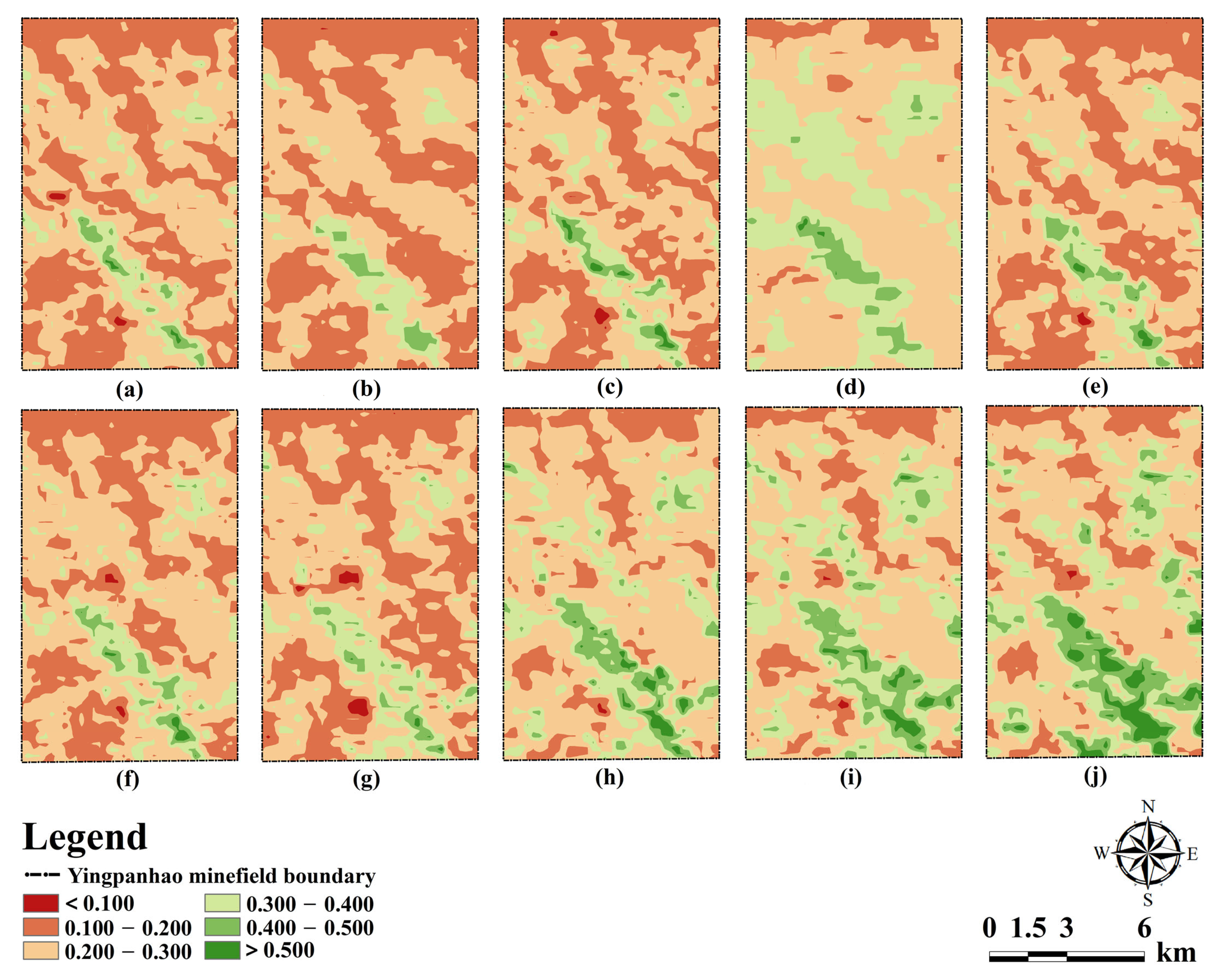




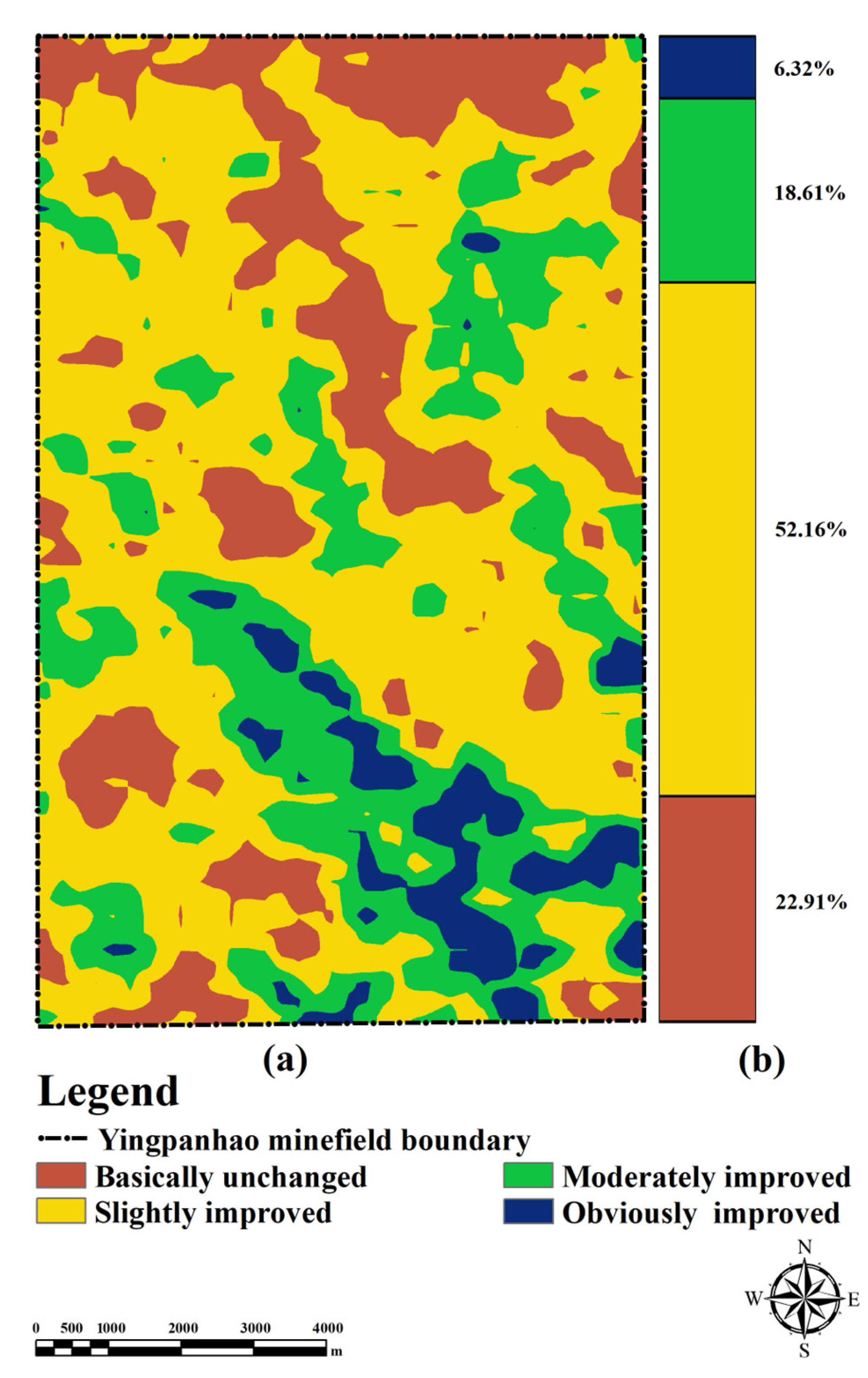


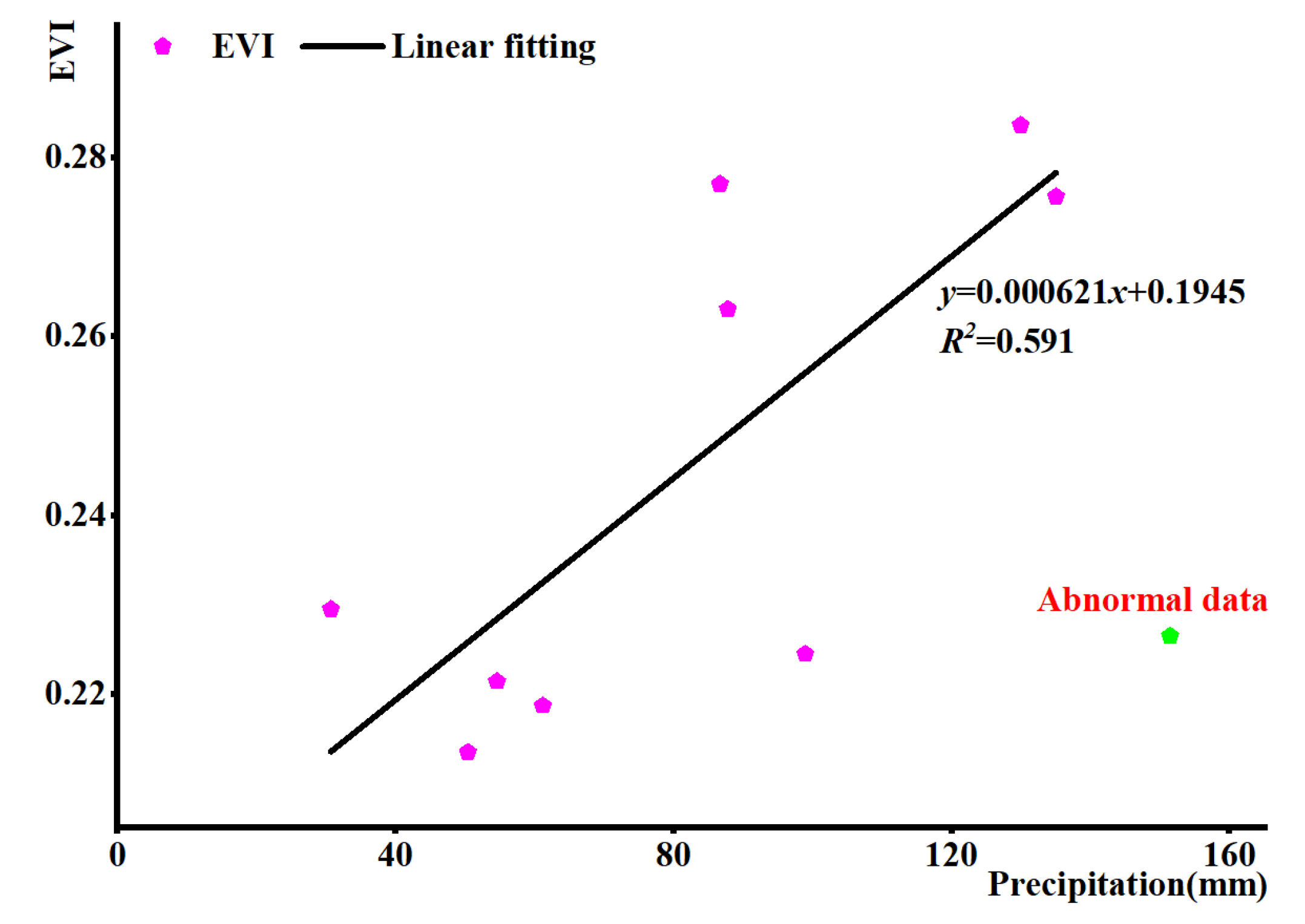
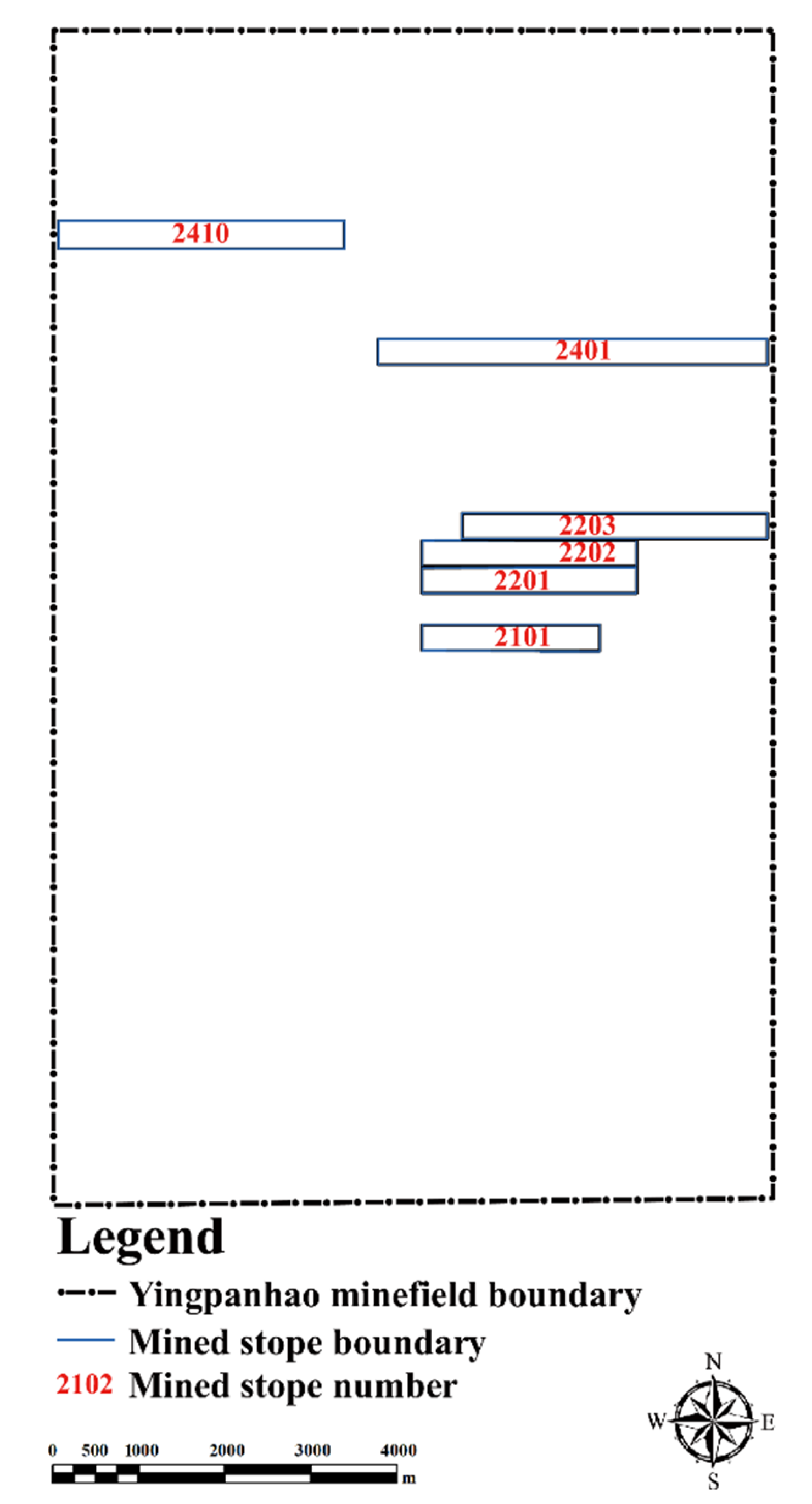
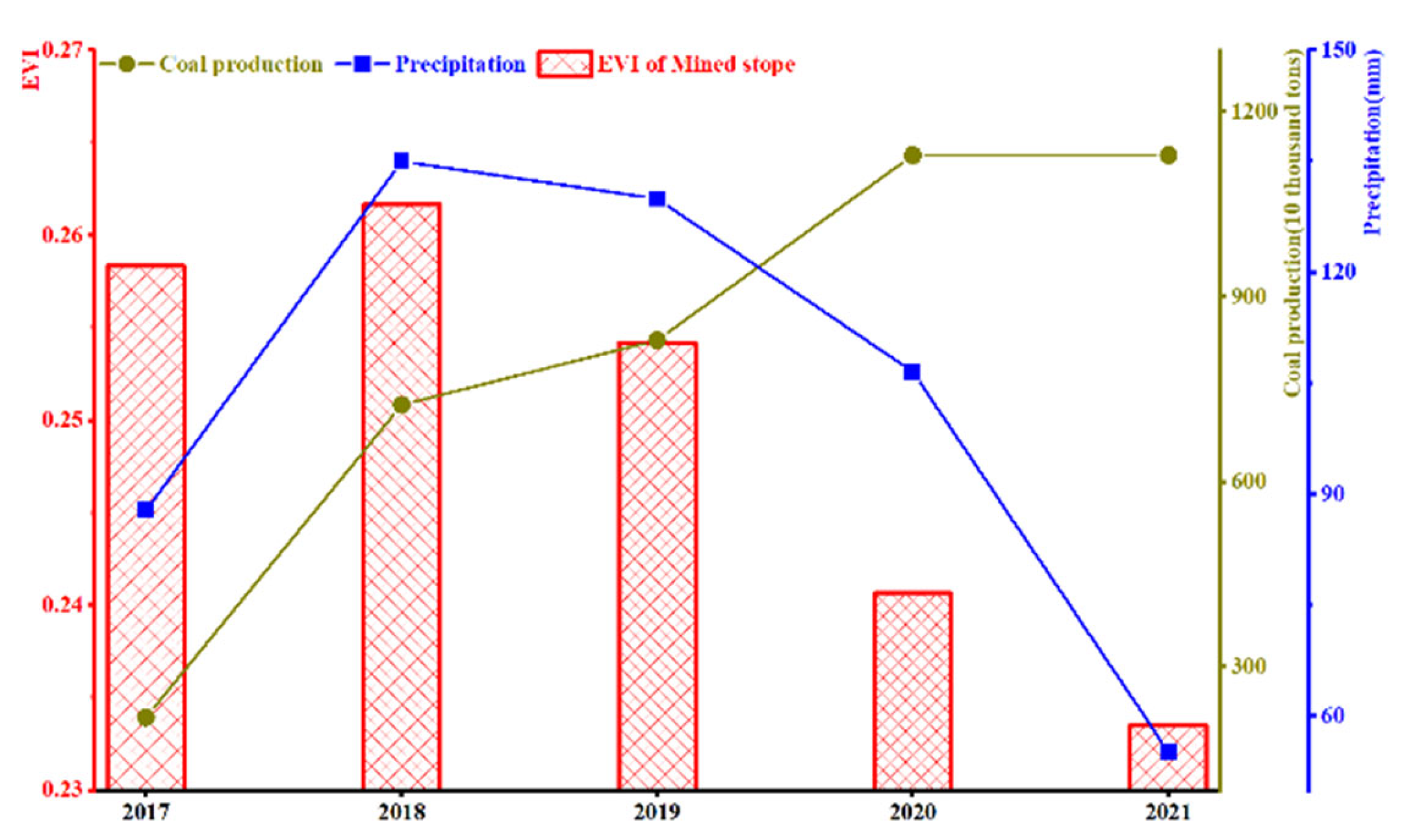


| Model Summary a | AVOVA a | Coefficients a | |||||
|---|---|---|---|---|---|---|---|
| F | Sig. | Unstandardized Coefficients | Collinearity Statistics (VIF) | ||||
| R | 0.992 b | Regression | 59.052 | 0.017 | Constant (β0) | 0.241 | |
| R2 | 0.983 | Residual | Coal production (β1) | −0.208 | 1.005 | ||
| Adjusted R2 | 0.967 | Total | Precipitation (β2) | 0.251 | 1.005 | ||
| Control Variable | Coal Production | ||
|---|---|---|---|
| Precipitation | EVI | Correlation | −0.979 |
| Significance (2-tailed) | 0.021 | ||
| df | 2 | ||
| Control Variable | Precipitation | ||
| Coal production | EVI | Correlation | 0.985 |
| Significance (2-tailed) | 0.015 | ||
| df | 2 |
Publisher’s Note: MDPI stays neutral with regard to jurisdictional claims in published maps and institutional affiliations. |
© 2022 by the authors. Licensee MDPI, Basel, Switzerland. This article is an open access article distributed under the terms and conditions of the Creative Commons Attribution (CC BY) license (https://creativecommons.org/licenses/by/4.0/).
Share and Cite
Yang, Z.; Li, W.; Li, L.; Lei, S.; Tian, J.; Wang, G.; Sang, X. Spatiotemporal Variation and Influencing Factors of Vegetation Growth in Mining Areas: A Case Study in a Colliery in Northern China. Sustainability 2022, 14, 9585. https://doi.org/10.3390/su14159585
Yang Z, Li W, Li L, Lei S, Tian J, Wang G, Sang X. Spatiotemporal Variation and Influencing Factors of Vegetation Growth in Mining Areas: A Case Study in a Colliery in Northern China. Sustainability. 2022; 14(15):9585. https://doi.org/10.3390/su14159585
Chicago/Turabian StyleYang, Zhi, Wenping Li, Liangning Li, Shaogang Lei, Jiawei Tian, Gang Wang, and Xuejia Sang. 2022. "Spatiotemporal Variation and Influencing Factors of Vegetation Growth in Mining Areas: A Case Study in a Colliery in Northern China" Sustainability 14, no. 15: 9585. https://doi.org/10.3390/su14159585
APA StyleYang, Z., Li, W., Li, L., Lei, S., Tian, J., Wang, G., & Sang, X. (2022). Spatiotemporal Variation and Influencing Factors of Vegetation Growth in Mining Areas: A Case Study in a Colliery in Northern China. Sustainability, 14(15), 9585. https://doi.org/10.3390/su14159585





